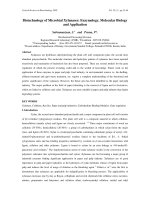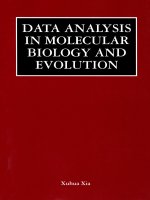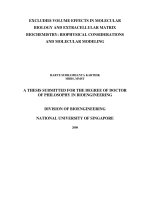Molecular biology and pathogenesis of coronavirus virus and host factors involved in viral RNA transcription
Bạn đang xem bản rút gọn của tài liệu. Xem và tải ngay bản đầy đủ của tài liệu tại đây (29.49 MB, 259 trang )
MOLECULAR BIOLOGY AND PATHOGENESIS OF
CORONAVIRUS: VIRUS AND HOST FACTORS INVOLVED IN
VIRAL RNA TRANSCRIPTION
TAN YONG WAH
(B. SC., NATIONAL UNIVERSITY OF SINGAPORE)
A THESIS SUBMITTED FOR THE DEGREE OF
DOCTOR OF PHILOSOPHY
DEPARTMENT OF BIOCHEMISTRY
NATIONAL UNIVERSITY OF SINGAPORE
2012
ii
Acknowledgements
I would like to thank Associate Professor Liu Ding Xiang for his mentorship and
unceasing guidance for the past five years working on this thesis. I would also like to
thank Professor Hong Wanjin and Associate Professor Zhang Lianhui for their critical
feedback during the annual progress review meetings which have definitely made a
positive impact on the work that has been done.
I would like to express my gratefulness for the help and guidance provided by the
members of the Molecular Virology and Pathogenesis Lab in IMCB. Special thanks to
Dr. Xu Linghui for her advice on yeast-related work and Dr. Fang Shouguo for his
advice on molecular techniques. My heartfelt gratitude goes to Felicia, Huihui,
Yanxin, Siti, Selina, Dr. Nasir, Dr. Yamada and Dr. Wang Xiaoxing for their
everyday advice on my experiments and support when difficulties were encountered.
I would also like to thank IMCB for providing me with an opportunity to further my
studies under the Scientific Staff Development Scheme, Dr. Shanthi Wasser for
allowing me to continue using the BSL2+ containment facility after the lab has moved
out and Associate Professor Tan Yee Joo for allowing me to work in her lab at IMCB
for several months. Lastly, I would like to thank my husband for his unceasing love
and understanding for the past five years which has allowed me to focus on my
research.
iii
Table of Contents
Summary vii!
List of Tables ix!
List of Figures x!
List of Publications xvi!
Chapter 1! Literature Review: The Biology of Coronavirus 1!
1.1 Overview of Coronaviruses 2!
1.2 The Coronavirus Life Cycle 8!
1.3 Virus-host interactions 26!
1.4 Objectives 42!
Chapter 2! Materials and Methods 44!
2.1 Chemicals and Reagents 45!
2.2 Yeast three-hybrid Screening 49!
2.3 Mammalian Cell Culture 56!
iv
2.4 Virology Methods 58!
2.5 Polymerase Chain Reaction (PCR) 62!
2.6 Nucleic Acid Manipulation Techniques 63!
2.7 Molecular Cloning Techniques Involving E. coli 67!
2.8 Construction of Clones 69!
2.9 Generation Of Template DNA For In vitro Transcription Labeling of RNA
Probes 77!
2.10 In-vitro transcription 79!
2.11 Mammalian Gene Over-Expression and Gene Silencing 80!
2.12 Gene over-expression in E. coli by induction 83!
2.13 Immunofluorescence Detection 84!
2.14 Cell Fractionation 85!
2.15 Luciferase Assay 86!
2.16 Detection of IBV and Host mRNAs by RT-PCR 86!
2.17 SDS Polyacrylamide Gel Electrophoresis (SDS-PAGE) 88!
2.18 Western Blot 90!
2.19 Northern Blot 91!
v
2.20 North-Western Blot 93!
2.21 Biotin Pull-down Assay 94!
Chapter 3! Characterization of interaction between host protein MADP1 and
coronavirus 5’-UTR 96!
3.1 Human MADP1 Interacts with SARS-CoV 5’-UTR 99!
3.2 MADP1 Interacts with IBV 5’-UTR 104!
3.3 MADP1 Translocated to the Cytoplasm during IBV Infection 116!
3.4 MADP1 Interacts Specifically with IBV 5’-UTR (+) 124!
3.5 Stem Loop I of IBV 5’-UTR (+) is required to interact with MADP1 127!
3.6 The RNA Recognition Motif Domain of MADP1 is required to interact with
IBV 5’-UTR (+) 132!
3.7 Transient Gene Silencing of MADP1 Reduced Viral Replication and
Transcription 137!
3.8 The Impact of MADP1 Silencing on IBV Infection using siRNA was not an
Off-Target Effect 150!
3.9 Expression of a Silencing-Resistant mutant MADP1 in a stable MADP1
Knock-Down Cell Clone Enhances IBV Replication 153!
3.10 MADP1 Interacts Weakly with Human Coronavirus OC43 (HCoV-OC43) 5’-
UTR (+) 158!
vi
3.11 MADP1 Interacts with IBV 3’-UTR (+) 160!
3.12 A Correlation of MADP1 Expression Level to IBV Infectivity could not be
Established 162!
3.13 Discussion 166!
Chapter 4! Interaction Between Non-Structural Proteins With Viral RNA And
Proteins. 173!
4.1 Biotin pull-down screen for RNA-binding activity of non-structural proteins 175!
4.2 Screen for non-structural proteins interacting with nsp12 183!
4.3 Nsp8 interacts with the N- and C-terminal portions of nsp12 194!
4.4 Discussion 195!
Chapter 5! Conclusions and Future Directions 198!
5.1 Main Conclusions 199!
5.2 General Discussion 202!
5.3 Future Directions 211!
References 214!
vii
Summary
A successful coronavirus infection is characterized by the release of infectious
progeny particles which entails the replication of the viral genome and its packaging
into infectious particles by its structural proteins. These two processes are dependent
upon its ability to synthesize both the positive-sense genomic mRNA and a set of
positive-sense subgenomic mRNAs for genome replication and viral proteins
expression respectively.
The cleavage products from the coronavirus replicase gene, also known as the non-
structural proteins (nsps), are believed to make up the major components of the viral
replication/transcription complex. Although viral RNA synthesis is thought to be one
of the most important parts of the virus life cycle, it is still not fully understood with
respect to how the complex functions as a whole, or the degree of cellular protein
involvement. Till date, only a number of enzymatic functions have been assigned to
several nsps and a handful of host proteins have been identified so far to play a role in
coronavirus RNA synthesis.
Zinc finger CCHC-type and RNA binding motif 1 (ZCRB1 alias MADP1) has been
identified as a possible host protein involved in RNA synthesis of coronaviruses. The
protein has found to interact with the positive-sense 5’untranslated region (UTR) of
infectious bronchitis virus (IBV) but weakly with that of severe acute respiratory
syndrome coronavirus (SARS-CoV) and human coronavirus OC43 (HCoV-OC43).
Further characterization of this interaction confirmed it to be specific and the
interacting domains have been subsequently mapped to the RNA recognition motif
domain of MADP1 and stem-loop I of the positive-sense IBV 5’-UTR. It was
viii
observed that upon virus infection, MADP1 translocated to the cytoplasm, a deviation
from its regular nuclear localization pattern, an indication of possible involvement in
the virus life cycle.
Functional analyses using small interfering RNA to silence the gene has elucidated
the function of MADP1, a determinant of efficient negative-sense RNA synthesis. A
confirmation of the role of MADP1 in virus infection was obtained when it was
shown that the expression of MADP1 resistant to the silencing effects of the hairpin
RNA targeting MADP1 enhanced virus infection in stable MADP1 knock-down cells.
While progress has been made on host involvement in coronavirus RNA synthesis,
the role of viral proteins has not been forgotten. Several nsps encoded by IBV were
screened for RNA-binding activity and interaction with its RNA-dependent RNA
polymerase, nsp12. Four non-structural proteins, nsp2, nsp8, nsp9 and nsp10 were
found to bind to either of the UTRs assessed and nsp8 was confirmed to interact with
nsp12. Nsp8 had been reported to form a complex with nsp7 which was functionally
assigned as the primase synthesizing RNA primers for nsp12.
Further characterization of the interaction between nsp8 and nsp12 revealed that the
interaction is independent of the presence of RNA was subsequently shown that nsp8
interacts with both the N- and C-termini of nsp12. These results have prompted a
proposal of how the nsp7-nsp8 complex could possibly function in tandem with
nsp12, forming a highly efficient complex which could synthesize both the RNA
primer and viral RNA during coronavirus infection. (507 words)
ix
List of Tables
Table 2.1: List primers used to amplify SARS 5'- and 3'- untranslated regions. 69!
Table 2.2: Primers used to amplify MADP1 from HeLa cDNA for cloning into
pDONR
TM
221 vector. 70!
Table 2.3: List of primer sequences used in the cloning of all full-length and truncated
MADP1 constructs. 71!
Table 2.4: List of all primer sequences used in the generation of mutants of
pXJ40Flag-MADP1. 73!
Table 2.5: List of primers used in the generation of stem loop I mutant plasmids. 74!
Table 2.6: Primers used to clone HCoV-OC43 5'-UTR. 75!
Table 2.7: Oligonucleotide sequence used for generating hairpin siRNA insert. 75!
Table 2.8: List of primers used in the cloning of IBV nsp 12 truncation mutants. 76!
Table 2.9: List of primers used to amplify PCR fragments used as templates for
transcription of biotin-labeled probes. 78!
Table 2.10: Target sequence of siRNAs used for silencing MADP1. 81!
Table 2.11: Primers used for amplifying IBV mRNAs, MADP1 mRNA and GAPDH
mRNA. 87!
Table 3.1: Volumes (in microlitres) of each 50 µM siRNA used in the different
siRNA pool combinations. 151!
Table 3.2: Band densities of MADP1 (normalized with band densities of actin for
each cell line) in 16 cell lines classified by tissue of origin. 163!
x
List of Figures
Figure 1.1: Schematic diagram of a coronavirus particle. 2!
Figure 1.2: Genome Organization of selected coronaviruses. 3!
Figure 1.3: Life cycle of a coronavirus. 9!
Figure 1.4: Domain organization of the replicase polyproteins pp1a and pp1ab (pp1a
joined with pp1b). 13!
Figure 1.5: The transcription of gammacoronavirus IBV produces a nested set of 6
positive-sense mRNAs that are 5'- and 3'- co-terminal. 14!
Figure 1.6: Discontinuous transcription in negative-strand synthesis of
gammacoronavirus IBV. 18!
Figure 1.7: A model of discontinuous transcription in coronaviruses in three steps. 19!
Figure 1.8: Virus-host interaction in innate immune response. 31!
Figure 1.9: Coronavirus-encoded proteins interfere with the cell cycle. 32!
Figure 1.10: The activation of apoptosis by coronavirus-encoded proteins. 36!
Figure 2.1: An overview of the yeast three-hybrid system. 49!
Figure 2.2: Screening process using the yeast three-hybrid system 52!
Figure 2.3: TCID
50
calculation by Reed-Muench method. 61!
Figure 3.1: Colony PCR of colonies isolated from three-hybrid screen with SARS-
CoV 5'-UTR (+). 100!
Figure 3.2: Colony PCR of colonies isolated from three-hybrid screen using SARS-
CoV 5'-UTR (-) and 3'-UTR (-). 101!
xi
Figure 3.3: Repeat of colony PCR using a different annealing temperature with clones
A83, A127, A250, B169, B225, isolated from three-hybrid screen with SARS-CoV 5'-
UTR (+). 101!
Figure 3.4: No expression of HIS-MADP1 was detected after induction at 1 mM
IPTG for 3 hours at 37°C. 104!
Figure 3.5: Expression of HIS-MADP1 was too low to be detected by coomassie blue
staining. 105!
Figure 3.6: Expression of GST-MADP1 was too low for detection by coomassie blue
staining. 106!
Figure 3.7: GST-MADP1 expression still could not be detected after reducing the
concentration of IPTG to 0.8 mM. 107!
Figure 3.8: Expression of GST was confined to the insoluble fraction. 108!
Figure 3.9: Expression profile of GST-MADP1 appeared to be similar to that of GST-
tag only. 109!
Figure 3.10: Lowering of IPTG concentration to 0.6 and 0.8 mM increased the
expression of GST-MADP1 but is still not detectable by coomassie blue staining. 110!
Figure 3.11: Lowering of induction temperature to 27°C did not further increase the
expression of GST-MADP1. 111!
Figure 3.12: FLAG-MADP1 expression was higher in Vero and H1299 cells
compared to HuH-7 cells. 112!
Figure 3.13: FLAG-MADP1 could not be detected by north-western blotting using
both IBV and SARS-CoV 5’-UTR (+) probes. 114!
Figure 3.14: MADP1 interacts with the 5'-UTR (+) of IBV and SARS-CoV. 115!
Figure 3.15: MADP1 localized predominantly in the nucleus but was detectable in the
cytoplasm. 117!
xii
Figure 3.16: Negative controls for indirect immuno-fluorescent detection of BrUTP
and FLAG-MADP1. 119!
Figure 3.17: FLAG-MADP1 was present in the cytoplasm of Vero cells during IBV
infection. 121!
Figure 3.18: FLAG-MADP1 was present in the cytoplasm of H1299 cells during IBV
infection. 122!
Figure 3.19: MADP1 interacts specifically with IBV 5’-UTR (+). 125!
Figure 3.20: Schematic diagram of biotinylated probes synthesized used to map the
MADP1 binding site on IBV 5'-UTR (+). 127!
Figure 3.21: The binding site for MADP1 lies in the first 140 nucleotides of the IBV
5’-UTR (+). 128!
Figure 3.22: Stem-loop I was required to retain the interaction between biotinylated
RNA and MADP1. 128!
Figure 3.23: Two mutations introduced to probe 5'-UTRΔ2 to create mutant probes 5'-
UTRΔ2M1 and 5'-UTRΔ2M2. 130!
Figure 3.24: The secondary structure of stem loop I was essential to bind MADP1. 131!
Figure 3.25: Schematic diagram of MADP1 truncation mutants used in the
determination of domain responsible for interacting with IBV 5'-UTR (+). 132!
Figure 3.26: The RRM domain interacted weakly with IBV 5’-UTR (+). 133!
Figure 3.27: Extension by a minimum of 14 amino acid residues of RRM domain or
MADP1n (amino acid residues 1 to 86), was required to achieve a RNA-binding
activity comparable to that of full-length MADP1. 134!
Figure 3.28: The MADP1 RRM domain active site residues are essential for its ability
to bind to IBV 5’-UTR (+). 136!
xiii
Figure 3.29: Silencing of MADP1 with Lipofectamine
®
RNAiMAX in H1299 and
Vero cells. 137!
Figure 3.30: MADP1 was efficiently silenced in H1299 cells but less efficiently in
Vero cells using DharmaFECT
®
Transfection Reagents. 138!
Figure 3.31: Silencing of MADP1 in H1299 cells reduced firefly luciferase activity
produced by IBV-Luc infection. 140!
Figure 3.32: Silencing of MADP1 in Vero cells slightly reduced firefly luciferase
activity produced by IBV-Luc infection. 142!
Figure 3.33: Replacement of culture medium after transfection increased luciferase
activities of cells infected with IBV-Luc virus. 143!
Figure 3.34: The silencing of MADP1 gene expression reduced the production of
infectious particles. 145!
Figure 3.35: The silencing of MADP1 in H1299 cells with siMADP1 reduced the
expression of viral structural genes S and N drastically. 146!
Figure 3.36: Silencing of MADP1 using siRNA resulted in the absence of cytopathic
effects (CPE) after infection with IBV-Luc virus. 148!
Figure 3.37: MADP1 silencing with siMADP1 reduced the amount of viral gRNA and
sgRNAs produced. 149!
Figure 3.38: Silencing of MADP1 using different combinations of siRNA pools
reduced luciferase expression from IBV-Luc recombinant virus. 152!
Figure 3.39: The mRNA level of MADP1 in shMADP1 cells were much lower
compared to shNC cells. 153!
Figure 3.40: The production of virus-specific mRNAs was reduced in shMADP1 cells
compared to shNC cells. 154!
Figure 3.41: Over-expression of shRNA-resistant MADP1 in stable MADP1 knock-
down cells (shMADP1) enhanced viral protein production. 155!
xiv
Figure 3.42: Over-expression of shRNA resistant MADP1 enhanced viral infectivity
as indicated by the increase in luciferase activity. 157!
Figure 3.43: Predicted stem loop I structures from IBV, SARS-CoV and HCoV-
OC43. 158!
Figure 3.44: MADP1 binds weakly to both SARS-CoV and HCoV-OC43 5'-UTR (+)
in a biotin pull-down assay. 159!
Figure 3.45: MADP1 interacted strongly with both 5’-UTR (+) and 3’-UTR (+) but
weakly with 5’-UTR (-). 160!
Figure 3.46: Western blot showing the amount of MADP1 and actin in 16 different
cell lines. 163!
Figure 3.47: All cell lines exhibited CPE upon IBV infection except SNU475, U937
and Y79. 165!
Figure 4.1: IBV nsp2, nsp5 and nsp10 showed binding activity to its 5’-UTR (+). 176!
Figure 4.2: IBV nsp5 and nsp10 showed binding activity to its 5’-UTR (-). 177!
Figure 4.3: IBV nsp5, nsp8 and nsp9 showed binding activity to IBV 3’-UTR (+). 178!
Figure 4.4: IBV nsp2 was confirmed to interact weakly with the single stranded viral
UTRs. 181!
Figure 4.5: IBV nsp5 was not confirmed to interact with the single-stranded viral
UTRs. 182!
Figure 4.6: Only HA-nsp12 was present in the sample after IP with HA-beads. 184!
Figure 4.7: IBV nsp8 co-precipitated with nsp12 in infected H1299 cells. 186!
Figure 4.8: IBV nsp8 co-precipitated with nsp12 in infected Vero cells. 188!
Figure 4.9: IBV nsp8 coprecipitates with HA-nsp12 and vice versa. 189!
xv
Figure 4.10: Higher molecular weight band observed from the IP was a non-specific
band. 190!
Figure 4.11: FLAG-nsp8 was precipitated by Myc-beads only when it was co-
expressed with Myc-nsp12. 192!
Figure 4.12: FLAG-nsp8 and Myc-nsp12 co-precipitates with or without RNase A
treatment. 193!
Figure 4.13: Schematic diagram of Myc-tagged nsp12 truncation mutant proteins. 194!
Figure 4.14: The N- and C-terminal portions of IBV nsp12 co-precipitated with
FLAG-nsp8 using FLAG-beads. 195!
xvi
List of Publications
1. Tan, Y.W., Hong, W. and Liu, D.X. (2012) Binding of the 5'-untranslated
region of coronavirus RNA to zinc finger CCHC-type and RNA-binding motif
1 enhances viral replication and transcription. Nucleic Acids Res.
2. Tan, Y.W., Fang, S., Fan, H., Lescar, J. and Liu, D.X. (2006) Amino acid
residues critical for RNA-binding in the N-terminal domain of the
nucleocapsid protein are essential determinants for the infectivity of
coronavirus in cultured cells. Nucleic Acids Res, 34, 4816-4825.
3. Fan, H., Ooi, A., Tan, Y.W., Wang, S., Fang, S., Liu, D.X. and Lescar, J.
(2005) The nucleocapsid protein of coronavirus infectious bronchitis virus:
crystal structure of its N-terminal domain and multimerization properties.
Structure, 13, 1859-1868.
1
Chapter 1 Literature Review: The Biology of Coronavirus
2
1.1 Overview of Coronaviruses
1.1.1 Taxonomy, genomic and physical properties of Coronaviruses
Coronaviruses are a group of enveloped RNA viruses whose genome is in the form of
a positive-sense single stranded RNA molecule. They are classified under the order of
Nidovirales, family of coronaviridae and subfamily of coronavirinae. Within this
subfamily, the coronaviruses are divided into three genera, the alpha-, beta- and
gammacoronavirus, based on their antigenic and genetic properties.
The outermost layer of the coronavirus particle, as depicted in the Figure 1.1 is a
double-membrane envelope, embedded with the virus structural proteins spike (S),
membrane (M) and envelope (E). Some betacoronaviruses are able to encode an
additional structural protein, the haemagglutinin-estarase (HE), which is also
represented on the double-membrane envelope. Encompassed within the virus
envelope is the ribonucleocapsid core, which comprised of two components: the viral
lipid bilayer
E
S
M
N
viral genome
core
Figure 1.1: Schematic diagram of a coronavirus particle.
3
mRNA genome and the structural protein, nucleocapsid (N). The N protein packages
and compact the fairly large viral genomic RNA into the relatively small sized virus
particle through RNA-protein interactions.
The coronavirus genome is a 5’-capped, single-stranded positive-sense mRNA, which
is the largest known of its kind, ranging from 27 to 32 kb in length (1). The mRNA is
flanked by two untranslated regions, the 5’-UTR, which ranges from 209 – 528
nucleotides (nt) in length, contains the leader sequence (65 – 98 nt) and the 3’-UTR
(288 – 506 nt), contains an octameric sequence of GGAAGAGC (beginning at residue
73 – 81) upstream of the poly(A) tail. As shown in Figure 1.2, coronaviruses have an
extremely large gene 1 (ORF 1), spanning about two-thirds of the entire genome,
which encodes for the non-structural proteins involved in viral RNA transcription.
Figure 1.2: Genome Organization of selected coronaviruses. Replicase and structural
genes and ribosomal frameshift site (RFS) are indicated. Internal ORF within N gene
encoded by betacoronaviruses is denoted I. Unlabeled blocks represent accessory
genes.
4
ORF 1 is translated into two poly proteins, pp1a and pp1ab via a pseudoknot-induced
frameshifting event upstream at the ORF1a/1b junction.
The structural genes are encoded in the order of S, E, M, N, 5’ – 3’, within the 3’ one-
third of the genome. Interspersed between these structural genes is a variable number
of ORFs encoding accessory proteins including HE. Some of these accessory genes,
like ORF 4, 5a (2,3), have been proven to be dispensable for virus replication in
cultured cells or even in their natural host (4).
The most prominent feature of the virus particle, and that which gives the coronavirus
its name, is the S protein, a large (≈180 kDa) class I virus fusion protein (5) embedded
in the virus envelope. S is cleaved post-translationally into two fragments by cellular
proteases (6,7), S1 (receptor binding domain) and S2 (transmembrane domain) that
interacts with each other through non-convalent bonding (8). S1 is responsible for
receptor recognition, defining cell tropism (9), whereas S2 mediates the fusion
between viral and cellular membranes through the fusion peptide sequence.
In betacoronavirus, phylocluster A, an additional protein is present on the viral
envelope, the HE protein. The ability to express the HE protein is lost in many
laboratory strains of the murine coronavirus (MHV) (10), including the widely studied
MHV-A59 (11), but is however retained in other laboratory strains like MHV-S, -
JHM and –DVIM (10,12,13) as well as field strains. The coronavirus HE protein has
been shown to exhibit both sialic acid binding and receptor-destroying enzymatic
activity (RDE) (14,15). The significance of sialic acid binding activity of HE varies
between coronaviruses, in bovine coronavirus (BCoV) and human coronavirus
(HCoV) OC43, HEs appear to play only a modest role in viral attachment to sialic
5
acids (16,17). On the otherhand, hemagglutination activity of MHV-DVIM appears to
depend upon the availability of HE.
The coronavirus N protein is a RNA chaperone (18) which is essential for the
formation of the helical ribonucleoprotein (RNP) core with viral genomic RNA that
which is also its primary function. The coronavirus N is composed of about 400
amino acid residues, contains two structural domains, the N-terminal RNA-binding
domain and the C-terminal dimerization domain joined by a linker region (19). The
coronavirus N has been shown to be capable of self-association, forming dimers or
oligomers of higher orders through its C-terminal dimerization domain (20,21) in a
concentration dependent manner (22). The ability of N to self-associate and its
subsequent formation of oligomers is vital for the encapsidation of coronaviral
genomic mRNA (23). It has also been reported that the dimerization domain exhibits
strong RNA-binding activity (24) and its association with nucleic acids can promote
the formation of higher-order oligomers (25) which may have been the mechanism for
the long RNP formation.
Embedded within the viral envelope is another structural protein of the coronavirus,
the integral membrane glycoprotein, M. In terms of its structure, the M protein has a
short ectodomain in its N-terminus, followed by three transmembrane regions and a
long endodomain at its C-terminus and functions in dimers. The main function of M is
in the adaptation of regions in the intracellular membranes, at the endoplasmic
reticulum-golgi intermediate compartment (ERGIC) (26), for virus assembly by
capturing other structural proteins at the budding site through protein-protein
interactions with other structural proteins, S and N (27) as well as the viral gRNA
6
(28). Its ability to self-associate (29,30) also allows it to form a network which may
have excluded some host proteins from the viral envelope.
A small integral membrane protein, the coronavirus envelope protein, E, is the
smallest structural protein encoded by the virus. The E protein plays an important role
in the formation of virus particles, including budding and morphogenesis (31-34). Its
importance is heightened by the observation of it being able to form virus-like
particles alone, in the absence of M, when it is over-expressed in cells (31,35).
Mutations of the E protein also results in the formation of virions with aberrant
morphologies (36) which implied the importance of E in viral morphogenesis.
1.1.2 Coronaviruses and diseases
Coronaviruses have identified in a variety of domesticated animals, rodents as well as
humans. As coronaviruses infect livestock, viral infections in farms have resulted in
large scale economic losses in farming nations, and hence are of exceptional
veterinary research value. Coronaviruses in fowls, exemplified by the highly
contagious infectious bronchitis virus (IBV) in chickens, can be highly lethal to young
chicks and are mainly associated with upper respiratory tract infections in adults, and
to a lesser extent, nephrogenic infections. In larger livestock like pigs and cattle on the
otherhand, coronaviruses typically establish enteric infections. In both cases, an
infection or outbreak can cause severe economic losses from death of young, lifelong
impact on the yield of animal produce (eggs and milk), weight losses and the general
health of the population. With respect to their significance to the economy, vaccines
have been developed for many coronaviruses in a bid to prevent localized infections
7
from progressing into serious outbreaks. This has however proved to be a hard battle
as the vaccines are unable to provide complete cross-protection between the various
serotypes of each coronavirus and have to be updated regularly to target emerging
strains.
Murine coronaviruses, exemplified by MHV, can cause high mortality epidemic
illness, which particularly impacts laboratory mice colonies which are kept in close
proximity. As the murine coronavirus infections complicate research, it has been
promptly picked up by researchers in order to exclude this disease from laboratories
worldwide, and was the most extensively studied coronavirus before 2002.
Human coronaviruses have, in the recent years, been placed in the limelight with the
emergence of severe acute respiratory virus (SARS-CoV) in late 2002, infecting more
than 8000 people with a mortality rate of roughly 10%. Prior to the outbreak, human
coronaviruses, being the etiologic agent responsible for 10-15% of common cold,
have received little attention due to the mild display of symptoms although they may
result in fatalities, especially in in weaker individuals complicated by other diseases.
After the SARS-CoV epidemic, 2 new human coronaviruses have also been isolated,
the alphacoronavirus HCoV-NL63 and betacoronavirus HCoV-HKU.
8
1.2 The Coronavirus Life Cycle
There are multiple stages in the coronavirus life cycle and the very first step would be
its attachment to a suitable host cell via cellular receptors followed by the entry of the
virus particle into the cytosol where the helical virus genome is released from the N
protein it was packaged with. The virus genome is a 5’-methyl capped positive sense
mRNA which mimics the eukaryotic mRNAs and hence is able to make use of the
existing ribosomes to translate its genome. Only the ORF on the 5’ most of the
mRNA, the replicase gene, is translated, producing two polyproteins, pp1a and pp1ab
via a (-1) ribosomal frame shift event. These two polyproteins are auto-proteolytically
cleaved into the non-structural proteins co-translationally. The non-structural proteins
make up the bulk of the replication/transcription complex (RTC) which is anchored
onto double membrane vesicles (DMVs), the site where virus transcription/replication
takes place (37-39).
The products of the RTCs is a nested set of mRNAs that are co-terminal at both their
5’- and 3’- ends and the longest being mRNA1, the genomic-sized mRNA (gRNA)
and the sub-genome sized mRNAs (sgRNAs) which are destined to be packaged into
progeny virus particles and used for viral structural and accessory gene expression
respectively. Translation of the structural genes produces the viral S, E, M and N
proteins which are assembled at the endoplasmic reticulum-golgi intermediate
compartment (ERGIC) together with the gRNA into progeny viruses which are
eventually exported out of the host cell via exocytosis.
9
Figure 1.3 is a diagrammatic representation of the key events in the coronavirus life
cycle, a slightly modified version of that published by Stadler et al. (2003) (40).
Figure 1.3: Life cycle of a coronavirus. Virus particle attached onto the host cell
via cellular receptors on the surface and enters. Entry is followed by the uncoating
of the ribonucleocapsid to expose the positive-sense genomic RNA which is
translated by the host ribosomes to yield the viral replication complex. Viral
transcription and replication of genome is achieved by the viral replication
complex, yielding a nested set of positive-sense sub-genomic sized mRNAs as
well as the full length virus genome. Sub-genomic sized mRNAs are translated by
host ribosomes into viral structural (S, E, M, N) and accessory proteins. The N
protein packages the positive-sense genomic RNA into a ribonucleocapsid and is
assembled into the virus particles. The newly formed virus particles undergo
maturation by passaging through the Golgi and exit the host cell via exocytosis.









